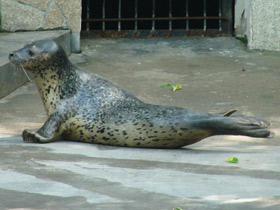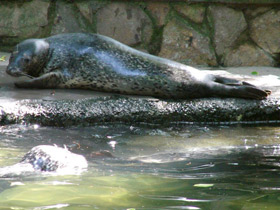The spotted seal, the larga seal or largha seal (Phoca largha)
The spotted seal (Phoca largha), also known as the larga seal or largha seal, is a member of the family Phocidae, and is considered a "true seal". It inhabits ice floes and waters of the north Pacific Ocean and adjacent seas. It is primarily found along the continental shelf of the Beaufort, Chukchi, Bering and Okhotsk Seas and south to the northern Yellow Sea and it migrates south as far as northern Huanghai and the western Sea of Japan. It is also found in Alaska from the southeastern Bristol Bay to Demarcation Point during the ice-free seasons of summer and autumn when spotted seals mate and have pups. Smaller numbers are found in the Beaufort Sea. It is sometimes mistaken for the harbor seal to which it is closely related and spotted seals and harbor seals often mingle together in areas where their habitats overlap.
The reduction in arctic ice floes due to global warming led to concerns that the spotted seal was threatened with extinction. Studies were conducted on its population numbers, with the conclusion, as of October 15, 2009, that the spotted seal population in Alaskan waters is not currently to be listed as endangered by NOAA.
Etymology
The scientific name originated in the Greek word for seal, phoce, and larga, the term used by the Siberian Tungus people for this seal. The English common name comes from this seal's characteristic dark, irregularly shaped spots. Alaskan Eskimo names include issuriq (Central Alaskan Yup'ik language), gazigyaq in St. Lawrence Island Yupik, and qasigiaq in Inupiaq.
Appearance and habitat
Phoca largha is a species of pinniped mammal in the phocidae family (Phocidae).
Phoca largha is common in the North Pacific Ocean off the coasts of Asia and North America, from the Chukchi Sea to Korea and California.
This seal has a small but fairly dense body, with a small head and elongated snout. Adults reach a length of 190-220 cm, in autumn the maximum weight can be 130-150 kg, in spring it usually does not exceed 80-100 kg.
The colouring of these seals is quite variable and can vary from silver-grey to dark grey. The Phoca largha has small, irregularly shaped black or brown spots all over the back, sides and belly, and usually more spots on the head and back.
Favourite haunts of spotted seals are shallow bays, small islands and isolated groups of rocks near the coast. It is not uncommon for them to swim up rivers during the salmon run. In the water, Phoca largha are confident and often curious about approaching boats. However, this species is very cautious, fearful of humans and may even leave its habitat if constantly disturbed. Spotted seals do not form large aggregations; haul-outs can number from a few dozen to 100 or more seals. In spring, however, concentrations of Phoca largha can be seen in the Tatar Strait and on the northwest coast of Sakhalin.
Behavior
Spotted seals are relatively shy and are difficult for humans to approach. They can be solitary in general but are gregarious and form large groups during pupping and molting seasons when they haul out on ice floes or, lacking ice, on land. The numerically largest groups in Alaska are at Kasegaluk Lagoon in the Chukchi Sea, near Cape Espenburg in Kotzebue Sound, and in Kuskokwim Bay on sandbars and shoals, where several thousand may collect.
Sexual maturity is attained around the age of four. January to mid-April is the breeding season. Pup births peak in mid-March. Spotted seals are believed annually monogamous, and during breeding season, they form "families" made up of a male, female, and their pup, born after a 10-month gestation period. Average birth size is 100 cm (39 in) and 12 kg (26 lb). Pups are weaned six weeks later. The maximum lifespan of the spotted seal is 35 years with few living beyond 25.
Spotted seals dive to depths up to 300 m (980 ft) while feeding on a variety of ocean prey. Juveniles eat primarily krill and small crustaceans while adults eat a variety of fish including herring, arctic cod, pollock, and capelin. They do not seem to vocalize a lot, although not much is known about their vocalizations. They appear to vocalize more while in molting groups. When approached in these groups, they make various sounds such as growls, barks, moans, and roars.
Based on satellite tracking conducted on Yellow Sea population, it was revealed that seals migrate more than 3,300 km (2,100 mi).
Reproduction
The Phoca largha gives birth on the ice or on the shore between January and mid-April. The young is born with white clothing, hence the name "squirrel". At one month of age, it acquires the mottled colour typical of adults. Until then, the hatchling feeds mainly on mother's milk, and then gradually begins to master solid food: catching small crabs, shrimps and octopuses. At first, this is done with the direct participation of the mother. During this time, the male joins the female and her young and waits until the female is ready to mate. Normally, the female will mate with the male while she is still lactating. In autumn, the young grow up and are able to feed themselves. But the attachment to their parents lasts for more than a year, and the seals often lie together in the haul-out. Females reach sexual maturity at 3-4 years, males at 4-5 years. The life expectancy of Phoca largha is about 35 years.
Conservation status
On March 28, 2008, the U.S. National Oceanic and Atmospheric Administration (NOAA) initiated a status review under the Endangered Species Act (ESA) to determine if listing this ice seal species under the ESA was warranted. After an 18-month review of the status of the spotted seal, NOAA announced on October 15, 2009 that two of the three spotted seal populations, together numbering 200,000 seals in or adjacent to Alaska, are not in danger of becoming extinct, nor are they likely to become so in the "foreseeable future", even though global warming has caused a loss in arctic ice mass. The announcement stated: "We do not predict the expected fluctuations in sea ice will affect them enough to warrant listing at this time."
In China, the spotted seal was under class-II national protection in the past, but the protection level was raised to class-I in 2021. The main threats to the species in China are global warming, marine traffic, industry noise, ocean pollution, and poaching for aquarium exhibition.
In South Korea, spotted seals have been designated Natural Monument No. 331 and second-class endangered species. An environmental activist group Green Korea United is currently working closely with local Chinese government to stop the seals from being poached by Chinese fishermen.

















































